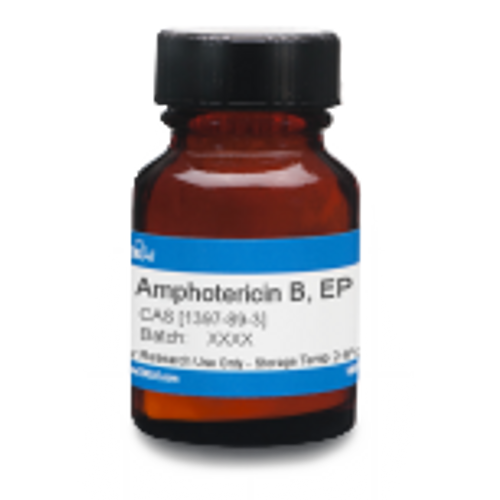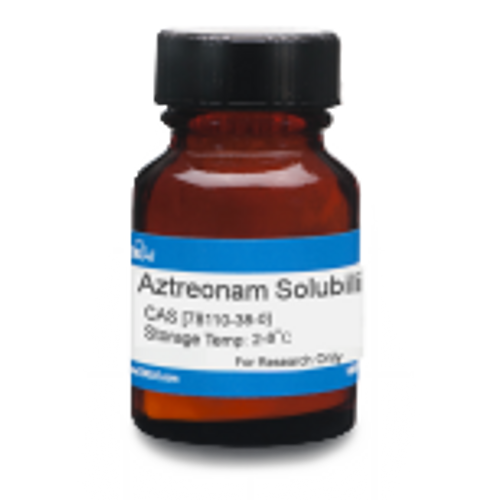Amphotericin B, Solubilized, Lyophilized is an optimized version of Amphotericin B. It is formulated with sodium deoxycholate to maximize the water solubility as lipotrophic molecules such as deoxycholate improve its solubility. Although Amphotericin B has an amphiphilic region, its water solubility is inherently low. The product has also been lyophilized to remove moisture, enhance stability and improve shelf life.
Amphotericin B is a a polyene macrolide aminoglycoside broad-spectrum antimycotic. This bioactive natural product was originally isolated from soil collected from the Orinoco River (Venezuela) in 1955 and identified as Streptomyces nodosus by Squibb Institute for Medical Research. It is used to control contamination from fungi, viruses and protozoa and a common media selective agent to inhibit the growth of background fungi. It also has immunomodulatory properties.
Amphotericin B, Solubilized, Lyophilized is soluble in water.
The Centers for Disease Control (CDC) Standard Operating Procedure (SOP) DSR-052-04 includes the addition of Amphotericin B to viral transport media.
We also offer:
| Mechanism of Action | Amphotericin B associates with membrane sterols (ergosterol in fungal cell membranes, and cholesterol in mammalian cell membranes). Amphotericin B forms a pore in these membranes resulting in leakage of essential ions and ultimately cell death.
Acquired resistance is very low, but is achieved in different ways. Some studies with biofilms have found it is due to decrease in ergosterol content and changes in the cell wall. Amphotericin B can modulate the immune system. It also induces the accumulation of nitric oxide and ROIs. |
| Spectrum | Amphotericin B is active against mammalian cells, fungi, viruses, and protozoa. Amphotericin B is not toxic to bacteria or viruses due to their lack of sterols. |
| Microbiology Applications |
Amphotericin B is used as an antimycotic selective agent in several routinely used selective media formulations to inhibit the growth of background fungal growth. According to the CDC SOP (DSR-052-04) for Viral Transport Medium (VTM), Amphotericin B is used at a final concentration of 0.5 µg/ml. Stock solution concentration is 250 µg/ml. While the toxicity of Amphotericin B in mammalian cells is associated with an increase in intracellular calcium, in Candida albicans, it is not dependent on increased movement of calcium across the cell membrane or the presence of extracellular calcium (Rogers et al, 2003). The isolation of influenza A and B viruses can be dramatically enhanced by adding Amphotericin B to the culture medium. It promotes viral uptake and endocytic processing of the virus particles (Roethl E et al (2011). The following represents MIC susceptibility data for Amphotericin B against common fungal pathogens:
|
| Plant Biology Applications | Amphotericin B can be used to inhibit phytopathogenic fungi in vitro |
| Eukaryotic Cell Culture Applications | Amphotericin B can be used in eukaryotic cell culture to control or prevent contamination from fungi, viruses, and protozoa. Amphotericin B can be toxic to cell lines at high concentrations and should not be used at concentrations greater than 2.50 µg/mL. Amphotericin B has been used in vitro to inhibit the generation of the scrapie isoform of the prion protein when studying transmissible spongiform encephalopathies (Mangé et al 2000).
Amphotericin B stimulates transcription and production of multiple mediators of the immune system (such as cytokines, chemokines, and prostaglandins) and ICAM-1 in murine and human cells (Arango et al, 2012). Amphotericin B powder is an improved formulation versus solution. Manosroi et al. found that at 45°C, Fungizone® solution had a shelf life of 2.5 days versus Fungizone® powder was 9.8 days. In this dry state, such degradation reactions can be significantly delayed or reduced and therefore dried media is recommended (ref).
|
| Molecular Formula | C47H73NO17 (Amphotericin B) |
| References |
Arango AC, Scorzoni L and Zaragoza O (2012) It only takes one to do many jobs: Amphotericin B as antifungal and immunomodulatory drug. Front. Microbiol. 3:286 PMID 23024638 Brajtburg, J, Powderly WG, Kobayashi GS, and Medoff G. (1990) Amphotericin B: Current understanding of mechanisms of action. Antimicrob. Agents and Chemother. 34 (2):183-88. PMID 2183713 Cavassin FB, Baú-Carneiro JL, Vilas-Boas RR, Queiroz-Telles F (2021) Sixty years of Amphotericin B: An overview of the main antifungal agent used to treat invasive fungal infections. Infect. Dis. Ther. 10(1):115-147 PMID 33523419 Centers for Disease Control and Prevention. 2020. DSR-052-02: Preparation of viral transport medium. Link to SOP. Mangé A et al. (2000) Amphotericin B inhibits the generation of the scrapie isoform of the prion protein in infected cultures. J. Virol. 74(7):3135-3140 PMID 10708429 Martin KW, Mattick KL, Harrison M, Humphrey TJ (2002) Evaluation of selective media for Campylobacter isolation when cycloheximide is replaced with Amphotericin B. Lett. Appl. Microbiol. 34(2):124-129 PMID 11849508 Perez-de-Luque A et al. (2012) Effect of Amphotericin B nanodisks on plant fungal diseases. Pest Manag. Sci. 68(1):67-74. PMID 21710554 Rice, LB, and Ghannoum MA (1999). Antifungal Agents: Mode of action, mechanisms of resistance, and correlation of these mechanisms with bacterial resistance. Clin. Microbiol. Rev. 12(4):501-517 PMID 10515900 Radomski N et al (2010) Comparison of culture methods for isolation of nontuberculous Mycobacteria from surfacewaters. Appl. Environ. Microbiol 76(11):3514-3520 PMID 20363776 Roethl E et al (2011) Antimycotic-Antibiotic Amphotericin B promotes influenza virus replication in cell culture. J. Virol. 85(21):11139-11145 PMID 21849438 Rogers PD, Kramer RE, Crews JK, Lewis RE (2003) The activity of Amphotericin B against Candida albicans is not directly associated with extracellular calcium concentration. J Antimicrob. Chemother. 51(2):305-312 Siqueira SD et al (2014) Influence of the freeze-drying process on the physicochemical and biological properties of pre-heated amphotericin B micellar systems. AAPS PharmSciTech. 15(3):612-619 PMID 24510525 Sokol-Anderson ML, Braitburg J, Medoff G (1986) Amphotericin B-induced oxidative damage and killing of Candida albicans. J. Infect. Dis. 154(1):76-83 PMID 3519792
|








